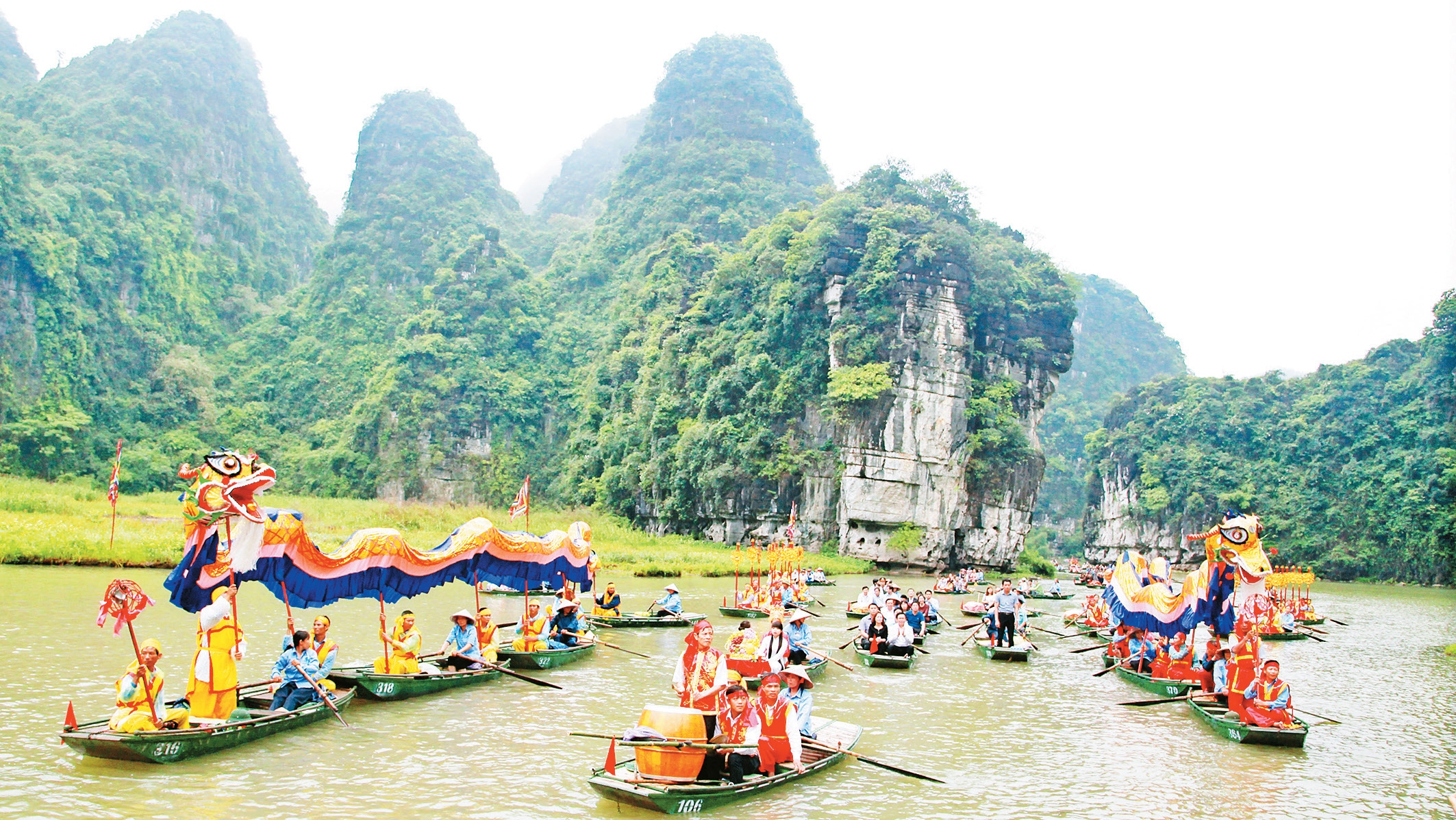A variety of classical karst towers and a network of caves connected by an intricate system of subterranean waterways, sunken hidden vestiges of ancient Vietnamese people, traces of invasions by sea, geology and geomorphology evolution and many sacred ancient temples and pagodas are the outstanding global values of Trang An Landscape Complex - the world's mixed cultural and natural heritage.
 People in Trang An Heritage area, Ninh Binh province welcome the spring festival (Photo:The Minh)
People in Trang An Heritage area, Ninh Binh province welcome the spring festival (Photo:The Minh)
Heritage’s values
Trang An, located in Ninh Binh province, was recognised by UNESCO as a World Natural and Cultural Heritage site, covering 6,226 hectares. The diversity of geological tectonics, unique culture, and majestic natural landscapes have helped the Trang An heritage area to form many river tours, cave tours, and spiritual tourism to well-known sacred temples.
According to Tran Thi Suu, a boatwoman at Trang An, Trang An ecotourism area under the Trang An Natural and Cultural Heritage site has three boat tours. With the first tour, takes visitors to nine caves, and three spiritual sites, including Tran Temple, Trinh Temple and Phu Khuong. The second tour takes visitors to four underground caves and the Thanh Cao Son temple, Vu Lam military base and the 'Kong: Skull Island' film studio. Travellers can visit Dot cave with its different stalactites, more than 1,000 metres long, and Suoi Tien Temple with the third tour. During the Tet holiday, Trang An welcomes a large number of domestic and international visitors. From the 25th to 26th day of the last lunar month, many boatman in Truong Yen commune, Hoa Lu district, Ninh Binh province, prepare to make banh chung (square glutinous rice cake), and organise year-end parties with their families. On the first and second day of the first lunar month, they again row boats to serve tourists visiting Trang An, see traces of ancient Vietnamese people and attend the Bai Dinh Pagoda Festival, which opens on the sixth day of the first lunar month.
Bai Dinh Pagoda is located in Gia Sinh commune, Gia Vien district, Ninh Binh province. It is known by millions of tourists with many established records in Vietnam and Asia. Bai Dinh Pagoda Festival opens many other festivals in Trang An Heritage area such as the King Dinh and King Le Temple Festival (known as Truong Yen Festival) taking place in the first days of the third lunar month. According to the custom of the local people, the rituals of Bai Dinh pagoda Festival includes: streaking bells, offering incense to Buddha; drumming to open festival, and ritual procession worship Cao Son to ancient Bai Dinh Pagoda. The festival draws tens of thousands of visitors, Buddhist monks, nuns and followers across the country. All pray for peace for the country, good weather, happiness and prosperity for all. Bai Dinh Pagoda Festival also features many folk games and art programme such as Cheo (Vietnamese traditional opera) singing, xam singing (ballads sung by wandering blind musicians), ca tru (ceremonial singing) and water puppetry. In 2018, the Dinh Tien Hoang's coronation and the Xa Tac worship ritual were re-enacted at Bai Dinh Pagoda.
Conservation for future generations
Both international visitors such as Dheeraj Dureddy from India and Nikita Gogia from Australia and domestic visitor such as Le Van Phuong from the Muong Thanh ward, Dien Bien Phu city, Dien Bien province, along with many tourists, who have visited Trang An Heritage area, have the same feeling: The nature here is beautiful, the cave is attractive, the Trang An people are friendly, and Trang An site Trang An deserves the world’s mixed natural and cultural property.
However, there are thousands of people living in Trang An heritage area, especially more than 14,000 people living in the core zone, posing difficulties and challenges for the tourism industry in terms of the management and conservation of the heritage associated with tourism development. Besides, awareness of the responsibilities of the community and of a number of commune and district officials for heritage protection, building a cultural and civilised environment in festivals and tourism services remains limited. That leads to the situation of some cases of Trang An heritage abuse being detected late or not handled in time. It is the "gap" in the state management of heritage.
Therefore, Ninh Binh province should focus on innovating and improving the effectiveness of state management of heritage; promoting socialisation, encouraging organisations, individuals and enterprises to effectively invest and exploit the global outstanding value of Trang An Heritage. The functional branches of the province should strengthen the inspection and review of policies and legal documents on heritage conservation that aims to timely adjust and supplement the legal basis, facilitating conservation in parallel with sustainable tourism development.
In order to keep the title of World Cultural and Natural Heritage, Ninh Binh province has fully implemented the recommendations of UNESCO on heritage conservation and issued a plan to manage Trang An Heritage Complex in the period of 2016-2020, with a vision to 2030.
LE HONG